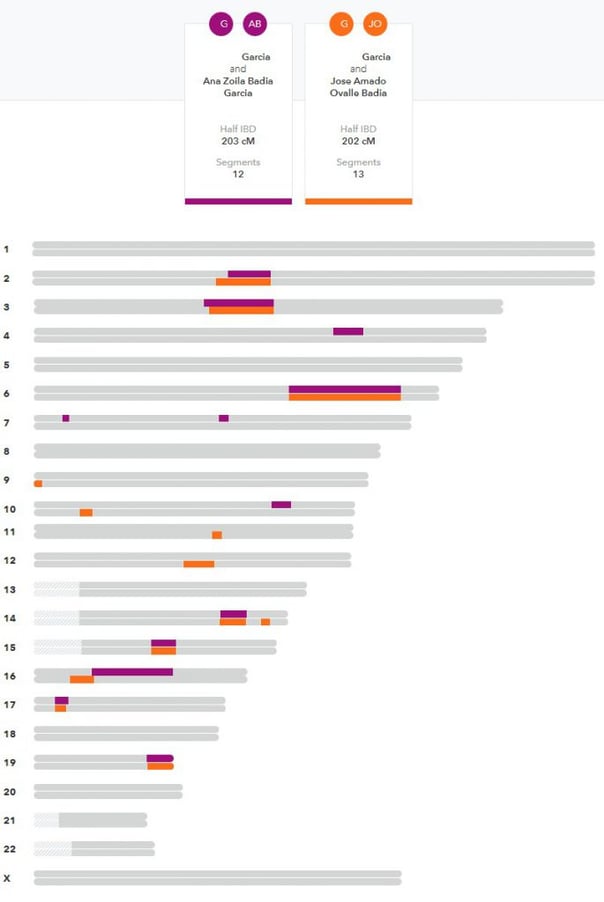 Recently I gave a webinar about choosing a DNA test and breaking down the differences between AncestryDNA, 23andme, and FamilyTreeDNA. When it came to autosomal DNA, I included the fact that 23andme and FamilyTreeDNA provide a chromosome view of how you share DNA with your matches while AncestryDNA does not, giving you just the summary of how much CentiMorgans are shared and along how many segments. For these reasons I do recommend people who test with AncestryDNA to also upload their DNA onto Gedmatch so they can better visualize some of their matches. A question I get concerns why does this matter? I now have an ideal example to share.
Recently I gave a webinar about choosing a DNA test and breaking down the differences between AncestryDNA, 23andme, and FamilyTreeDNA. When it came to autosomal DNA, I included the fact that 23andme and FamilyTreeDNA provide a chromosome view of how you share DNA with your matches while AncestryDNA does not, giving you just the summary of how much CentiMorgans are shared and along how many segments. For these reasons I do recommend people who test with AncestryDNA to also upload their DNA onto Gedmatch so they can better visualize some of their matches. A question I get concerns why does this matter? I now have an ideal example to share.
I recently got the 23andMe DNA results for my wife’s 86-year-old grandmother Zoila (the only living great-grandparent of our children), so I now have an example of DNA over four generations. Above left are her first four matches: her son, granddaughter, great-granddaughter, and a “Mr. Garcia.”
Garcia is the surname of Zoila’s mother, but is also a very common Spanish surname. I then clicked on shared matches between Zoila and Mr. Garcia:
This result was somewhat surprising. Mr. Garcia shared 2.72% DNA with Zoila over 12 segments, and then 2.71% DNA over 13 segments with Zoila’s son. (The fact that it’s 13 segments instead of 12 is not what is surprising, as one large segment could be reduced to two smaller segments.) What I would consider extremely unlikely is that Zoila would contribute nearly identical shared DNA over numerous segments perfectly to her son.
Because 23andMe allows you to see shared DNA bit by bit, I then compared Mr. Garcia to both Zoila and Jose along each chromosome.
From seeing the chromosomal comparison, it’s now quite clear what’s going on. While several of the shared DNA segments Jose has with Mr. Garcia are the same as those of his mother, there are also several unique segments both of them have. This means that Mr. Garcia would also have shared DNA with Jose’s father! (I can’t have him tested since he is deceased.) I have not found any way that Jose’s parents are related, but given that they are from the same area of Dominican Republic, a “common cousin” is not surprising. If you wonder how you can have more shared DNA with a match than your tested parent, this is one explanation.
This is the value of seeing shared DNA. If you are just told the amount of DNA and along each segments, and then see shared relatives, I might have concluded that Mr. Garcia was a genetic relative just through Jose’s mother, when Mr. Garcia was actually a genetic relative through both of Jose’s parents.
Share this:
About Christopher C. Child
Chris Child has worked for various departments at NEHGS since 1997 and became a full-time employee in July 2003. He has been a member of NEHGS since the age of eleven. He has written several articles in American Ancestors, The New England Historical and Genealogical Register, and The Mayflower Descendant. He is the co-editor of The Ancestry of Catherine Middleton (NEHGS, 2011), co-author of The Descendants of Judge John Lowell of Newburyport, Massachusetts (Newbury Street Press, 2011) and Ancestors and Descendants of George Rufus and Alice Nelson Pratt (Newbury Street Press, 2013), and author of The Nelson Family of Rowley, Massachusetts (Newbury Street Press, 2014). Chris holds a B.A. in history from Drew University in Madison, New Jersey.View all posts by Christopher C. Child →

